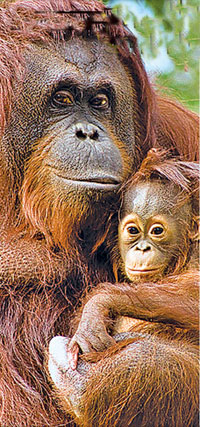|
Orangutans:
Critically endangered!
The only great apes found outside of Africa, the orangutans are
highly intelligent animals which are considered to be man's closest
relatives in the wilds sharing 97 per cent of our DNA.
 These
great apes are found in Asia, specifically on two islands - Borneo and
Sumatra. There are two separate species living in the lowland and hilly
tropical rainforests of these two islands. The Sumatran orangutan (Pongo
abelii) is smaller than its Bornean cousin (Pongo pygmaeus). These
great apes are found in Asia, specifically on two islands - Borneo and
Sumatra. There are two separate species living in the lowland and hilly
tropical rainforests of these two islands. The Sumatran orangutan (Pongo
abelii) is smaller than its Bornean cousin (Pongo pygmaeus).

They are the only strictly arboreal (relating to trees) apes and are
actually the largest tree-living mammals in the world. They are
sometimes called the 'Red apes' because of the unique bright reddish
brown coloured hair among apes, and are also referred to as the 'Man of
the Woods' due to the strong facial resemblance to humans.
These gentle red apes with an ability to think and reason are
threatened with extinction mostly due to loss of habitat. In fact, the
Sumatran species is listed as critically endangered while the Bornean
species is listed as engangered. It is estimated that there are fewer
than 7,000 Sumatran orangutans and 50,000 Bornean orangutans alive
today.
Some of you may have seen these great apes in real life at the zoo.
However, these intelligent animals especially with such human - like
abilities do not belong in cages. They are animals that should be
allowed to roam freely in their natural habitats on top of trees.
Orangutans are known for their remarkable ability to travel through the
forest tree tops and generally live in the forest canopy, building nests
about 100 feet above the ground. They are very much at home on top of
trees and travel from one place to another brachiating (swinging
arm-over-arm)
Orangutans have arms with a reach of more than eight feet! That is
more than the average height of an adult human. In fact, their arms are
longer than their legs and when stretched out their arm span is longer
than their body. Even though orangutans have two hands and two feet,
some may choose to say they have four hands instead of two because of
the way they use their feet 'as hands' especially to move about.
They are definitely graceful and agile when it comes to climbing, but
when on the ground, they are somewhat slow and awkward.
Perhaps their gait also contributes to their clumsy appearance when
walking on the ground. A male orangutan can weigh over 90 kilograms and
a female up to 50 kilograms. They are believed to be four to seven times
as strong as an adult human male. Male orangutans reach a height of
approximately 4.5 feet while females are about 3.5 feet tall. Their
hands are very much like ours. They have opposable thumbs which means
they can touch each of their fingers with their thumb.
As orangutans are very intelligent animals, they use tools to do many
things. Would you believe that these creatures sometimes use branches
and sticks to test the depth of water before entering it? They are also
known to use twigs to catch insects inside tree holes, use branches as
fly swatters to swish away mosquitoes that bother them and and use huge
leaves as umbrellas to protect themselves from heavy rain.
 Female
orangutans breed slower than any other primate and generally have three
offspring in their entire lifetime. They give birth to one offspring
every six to seven years. Female
orangutans breed slower than any other primate and generally have three
offspring in their entire lifetime. They give birth to one offspring
every six to seven years.
The orangutans have the longest childhood dependence on a mother of
any animals in the world. There's so much a baby orangutan needs to
learn in order to survive and the mother has to be around to teach the
offspring.
The babies usually nurse until they are about six years of age. Baby
orangutans cry when they are hungry, whimper when they are hurt and even
smile at their mothers.
 As
we explained earlier, orangutans live mostly on the tree canopy of the
rain forest. So, how do they find their food, you may wonder. From the
trees itself. As
we explained earlier, orangutans live mostly on the tree canopy of the
rain forest. So, how do they find their food, you may wonder. From the
trees itself.
Almost all of the food they eat grows in the treetops such as
tropical fruits (over 300 kinds) leaves, sprouts, bark and also insects.
The water they need is obtained from the leaves which fill with rain
water. When water is difficult to find, they chew leaves, make a sponge
out of it and soak up the droplets of water retained in tree cavities.
The orangutan babies therefore must know what food to eat, where to
find that food, in which trees and during which seasons.
The older orangutans seem to have a very complex map of the forest in
their minds with a detailed knowledge of the fruiting cycles of many
species of trees.
These gentle animals can live up to 35-50 years in the jungles if
their natural habitats are not destroyed and they are not caught or
killed by their human cousins. It is said that in captivity, they can
even live over half a century.
However, they may definitely prefer to live, even for a lesser period
of time, freely in their natural habitats than spend long lonely years
behind bars in a cage.
Don't you think wild animals are best left in their natural habitats?
Facts and pix: Internet.
***************
Fast facts
* Great apes are different from monkeys even though they are both
primates. Apes do not have tails.
* Orangutans emit a variety of calls and vocalisation including the
long call of the males and the kiss-squeak when any strangers get too
close to them. They can make 13-15 different vocalisations.
* They are diurnal, meaning they are active during the day.
* A male orangutan's cheek pads keep growing for most of its life.
* Orangutans have 32 permanent teeth (the same amount as we do).
Their canine teeth are very sharp with males having longer canine teeth.
* They build nests to sleep in every night, high up in the trees,
sometimes with roofs of leaves. |

